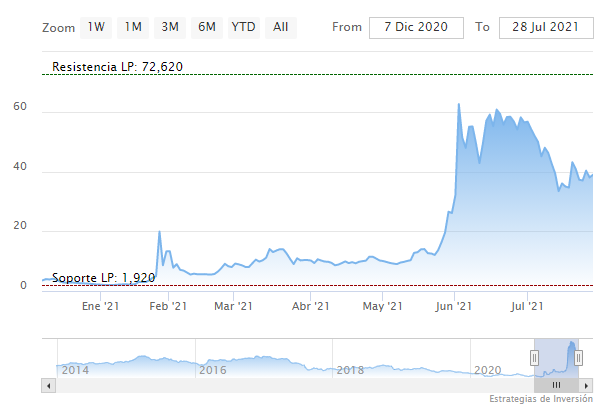#4981
Re: La actualidad de los mercados
Buenas tardes,
Bank of America va en dirección opuesta, opinan que las Small Caps tienen recorrido para largo, eso sí, con riesgos.
Saludos
---
BofA - 19/07 - Small-caps have outperformed on the back of improving economic conditions that should persist into the second half of the year. Reopening is likely to remain a tailwind, as smallcaps benefit from the release of consumer pent-up demand into services spending. June data from the National Federation of Independent Business (NFIB) suggests that small business hiring intentions and revenue expectations are on the rise—63% of business owners report hiring or trying to hire, while the percent of owners expecting higher sales volumes improved 5 points from the month prior.
Analyst earnings expectations also reflect an improving outlook for small-caps. Consensus now expects about 142% earnings growth for small-caps in 2021, versus 37% for large-caps. Valuations are supportive, as small-caps remain historically cheap compared to large-caps. The discount widened in June as the relative forward P/E of the Russell 2000 vs. Russell 1000 fell to 0.82x from 0.84x, its lowest level since November
Small-cap outperformance cycles tend to last for about a decade on average, indicating there could be room to run. Flows and positioning suggest potential for further upside: Recent inflows into small-caps have not eclipsed multiyear outflows, and active funds still remain under-allocated to smaller stocks, according to BofA Global Research.2 Rising rates could also be a tailwind, as the Russell 2000 Index saw double-digit returns during four of the last five time periods with a rising real fed funds rate.3
Our bullish outlook for small-caps is not without risk. The recent rotation from recoveryoriented sectors to secular growth areas led small-cap performance to pull back a bit this month, and momentum could be further dampened as liquidity conditions and the pace of growth begin to moderate. All things considered, we think that the outlook for small-caps is strong. From an asset allocation standpoint, we continue to prefer an overweight exposure to small-caps as part of a balanced portfolio
Bank of America va en dirección opuesta, opinan que las Small Caps tienen recorrido para largo, eso sí, con riesgos.
Saludos
---
BofA - 19/07 - Small-caps have outperformed on the back of improving economic conditions that should persist into the second half of the year. Reopening is likely to remain a tailwind, as smallcaps benefit from the release of consumer pent-up demand into services spending. June data from the National Federation of Independent Business (NFIB) suggests that small business hiring intentions and revenue expectations are on the rise—63% of business owners report hiring or trying to hire, while the percent of owners expecting higher sales volumes improved 5 points from the month prior.
Analyst earnings expectations also reflect an improving outlook for small-caps. Consensus now expects about 142% earnings growth for small-caps in 2021, versus 37% for large-caps. Valuations are supportive, as small-caps remain historically cheap compared to large-caps. The discount widened in June as the relative forward P/E of the Russell 2000 vs. Russell 1000 fell to 0.82x from 0.84x, its lowest level since November
Small-cap outperformance cycles tend to last for about a decade on average, indicating there could be room to run. Flows and positioning suggest potential for further upside: Recent inflows into small-caps have not eclipsed multiyear outflows, and active funds still remain under-allocated to smaller stocks, according to BofA Global Research.2 Rising rates could also be a tailwind, as the Russell 2000 Index saw double-digit returns during four of the last five time periods with a rising real fed funds rate.3
Our bullish outlook for small-caps is not without risk. The recent rotation from recoveryoriented sectors to secular growth areas led small-cap performance to pull back a bit this month, and momentum could be further dampened as liquidity conditions and the pace of growth begin to moderate. All things considered, we think that the outlook for small-caps is strong. From an asset allocation standpoint, we continue to prefer an overweight exposure to small-caps as part of a balanced portfolio








